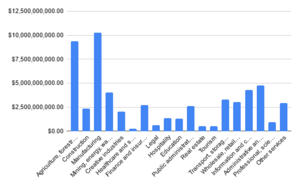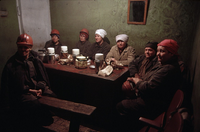Economy of Vanosha
The economy of Vanosha is a state controlled economy with a GDP of $57 Billion, giving it a GDP per capita of $3,473, making Vanosha the poorest nation in Vaniua and the X-th poorest nation on Sahar. An administrative-command system manages a distinctive form of central planning unique to the nation, reminiscent of Kuulist economic systems such as the Helsonian Union, though independently developed from the economic thought with its conception preceding the existence of the Helsonian model by a decade. The economy is based on the concept of state control of the means of production, corporatist farming, and industrial manufacturing.
Beginning in the late 20s and early 30s under premiers Svuso Vyerecev and Vaćeč Myerečev, the economy is characterized by state control of investment, dependence on resource production, public ownership of industrial assets, negligible job unemployment and high job security. The course of the economic system is guided by a series of 4 year plans. By the 1950s, the nation was considered industrialized, after struggling economically to catch up with the rest of the Vaniuan states. Following the a series of economic shortages as a result of the fall of the Kuulist powers of modern day Terminia and Qonklaks, Vanosha's economy suffered severe hardship. As a result, the economy had declined significantly before stagnating following the armistice of the border conflict with Khezan which firmly isolated the country from southward trade.
Economic sectors
Today, 25% of the nation's workforce are still employed by the agricultural, forestry, and mining sectors; while some 17% is involved in manufacturing. These two sectors are by far the most productive towards the total gross domestic output of the nation, after trade with the outside world declined since Lenezan's democratization which resulted initially in more access to Lenezi economic growth but resulted in short lived growth, followed by significant decline. In 1979, Vanosha's GDP per capita was $5,688 and was well under way to become a modern state within Vaniu, however, the 90s and early 2000s saw significant stagnation following by severe decline as a result of the cost of war and damage.
Agriculture, ranching, and forestry
The largest sectors by employment, the agricultural and mining sectors produce a sizable amount of resources. In agriculture, some half a million tonnes of apples were harvested in 2021, making it the largest producer of apples in Vaniu. In addition, Vanosha produces the second most tonnage of cotton on Sahar with 1.1 million tonnes harvested in 2021, behind Amerhan's 1.2 million tonnes.
In 2021, Vanosha produced:
- 1.428 million tonnes of Grain, oats, and barley
- 1.289 million tonnes of Potato
- 1.162 million tonnes of Cotton
- 540 thousand tonnes of Apples
- 472 thousand tonnes of Cheese
- 265 thousand tonnes of Nectarines
- 217 thousand tonnes of Wine
- 213 thousand tonnes of Pears
- 129 thousand tonnes of Herbal tea
- 107 thousand tonnes of Walnut
- 90,281 cubic meters of Timber
- 87,127 tonnes of Tomatoes
- 49 thousand tonnes of Tobacco
- 48 thousand tonnes of Sugar
- 17,210 tonnes of Peanuts
- 15,047 tonnes of Apricot
- 12,821 tonnes of Cherries
- 7,661 tonnes of Tea
- 4,872 tonnes of Almonds
- 4,259 tonnes of Pumpkin
- 1,762 tonnes of Beef
- 1,255 tonnes of Mushrooms
Mining
The mining sector is prominent, producing some 17 million tonnes of coal and 10 million tonnes of iron ore in 2021. From these produced and imported goods, some 7.2 million tonnes of steel were produced in 2021 alone, a tenth of neighboring Lenezan's 72 million.
In 2021, Vanosha produced:
- 17.218 million tonnes of Coal
- 9.8 million tonnes of Iron
- 7.2 million tonnes of Steel
- 1.478 million tonnes of Salt
- 110 thousand tonnes of Copper
- 108 thousand tonnes of Zinc
- 76.5 thousand tonnes of Nickel
- 29 tonnes of Silver
- 18 tonnes of Tin
- 1 tonne of Gold
- 1 tonne of Aluminum
Manufacturing
TBA


